Danu Toba, is a special place, a lake in a super volcano, the biggest volcanic caldera worldwide. Danau Toba, was formed about 100,000 to 75.000 years ago during one of the most powerful volcanic eruptions known to human kind; a tremendous disaster, which caused a layer of ashes of 600 meters to fall down.
In this Article
“It was the incredible beauty of an ancient, volcanic world, which through her cataclysms stayed a paradise of giants and gods.
There is something gigantic in this nature and herin lies Lake Toba as a blue jewel, luminescent between the pearl white, straight rocks.”
The Dutch Louis Couperus, writes in the style of the time, in his travel journal “Eastward” from 1923.
MYTH: On the creation of Lake Toba:
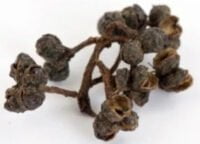
According to a legend and etymology, there was a mythical mountain called Mount Tuhaweoba in area of now Lake Toba. The mountain exploded, Lake Toba was created and the people who shared the land were divided.
Those on the western side of the lake became the Batak Toba and on the eastern side Batak Simalungun. Tuhaweoba is also the name of the Andaliman Wild Pepper also known as Indonesian Lemon Pepper. The word for pepper, Tuhaweoba changed over time into Tuba and later into Toba.
GEOMORPHOLOGY: On the creation of Lake Toba:

Danau Toba, was formed about 100,000 to 75.000 years ago during one of the most powerful volcanic eruptions known to human kind; a tremendous disaster, which caused a layer of ashes of 600 meters to fall down.
About 30,000 years ago, a new series of explosions formed a volcano inside the old one. The caldera lake that was formed by these explosions measures 100 km by 40 km, its odd elongate shape is a result of the interactions between the magma chamber and the shearing forces of the Sumatran Fault along the west that has stretched it out.
The pressure from the dormant magma, which has not erupted, caused Samosir Island to emerge.

The legend of Lake Toba and Putri Ikan
Once upon a time there was a young farmer named Toba. He lived in a fertile valley, therefore he was able to support his lonely, humble life with the crops he grew.
One day he went fishing at a river not far from his house. The river was usually rich with fish, but today he did not catch any fish, hungry, he decided to go home. Just as he was preparing to leave, his rod caught a big fish. As he lifted the big fish (ikan mas or ciprinius carpius), it suddenly talked – the golden fish cried and begged him to release it.
Surprised to see a talking fish, he released it to the river, but suddenly the fish transformed into beautiful young woman. The woman said that she was a princess cursed to be a fish. She thanked the farmer for breaking her curse and to show her gratitude, she was willing to be his wife under the condition that the farmer should not tell anybody about her being a fish or a terrible disaster would be. So the farmer and the woman got married and after a year, they were blessed with a baby boy (or a baby girl, there are different variations of the tale). The boy grew up to be a child of great appetite. He had a fierce appetite and would eat all the food on the table without leaving anything for his family.
One day the boy was asked to bring rice to his father who was working in the field. But on the way, the boy ate up everything. His father was very hungry and tired after the hard work, but there was no food left for him to eat. This made the farmer loose his temper and in anger, he hit the boy and called him a son of the fish.
Crying, the boy ran home and asked his mother if he really was a son of a fish. Shocked and sad to hear this, the princess told the boy to run to the hill near their house and to climb to the top of the tallest tree. She herself hurried up to the river where she met the young farmer the first time and disappeared.
The sky turned black and thunder and lightning roared and heavy rain fell onto the valley. It rained so hard and so long that the valley began to flood. The water got higher and higher until the valley was no more, it had turned into a lake.

Variants of the Legend of Lake Toba and Putri Ikan:
A Viennese original, our friend Chris, wearing a hat, almost bold and wrinkled, living in Toba for almost 40 years and married to Nurmin, an ever smiling Batak Lady, told us several variants to the legend:
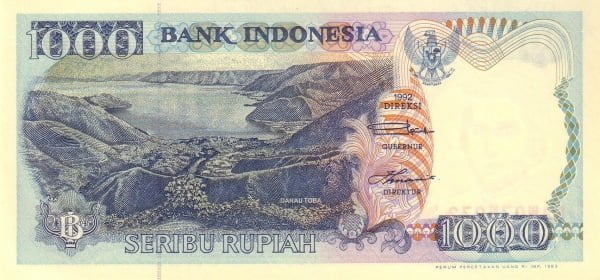
- The earth began to shake, and the volcano started to erupt. The earth cracked and formed a big hole. It is said that the hole became Toba Lake.
- The princess changed again into a very large fish that became the keeper of the lake and is worshiped till today.
- The father or the son became the island of Samosir.
- People named the lake after the farmer, Toba. The hill became an island in the middle of the lake, and was named Samosir Island. The son was believed to be the ancestor of Batak People of North Sumatera.
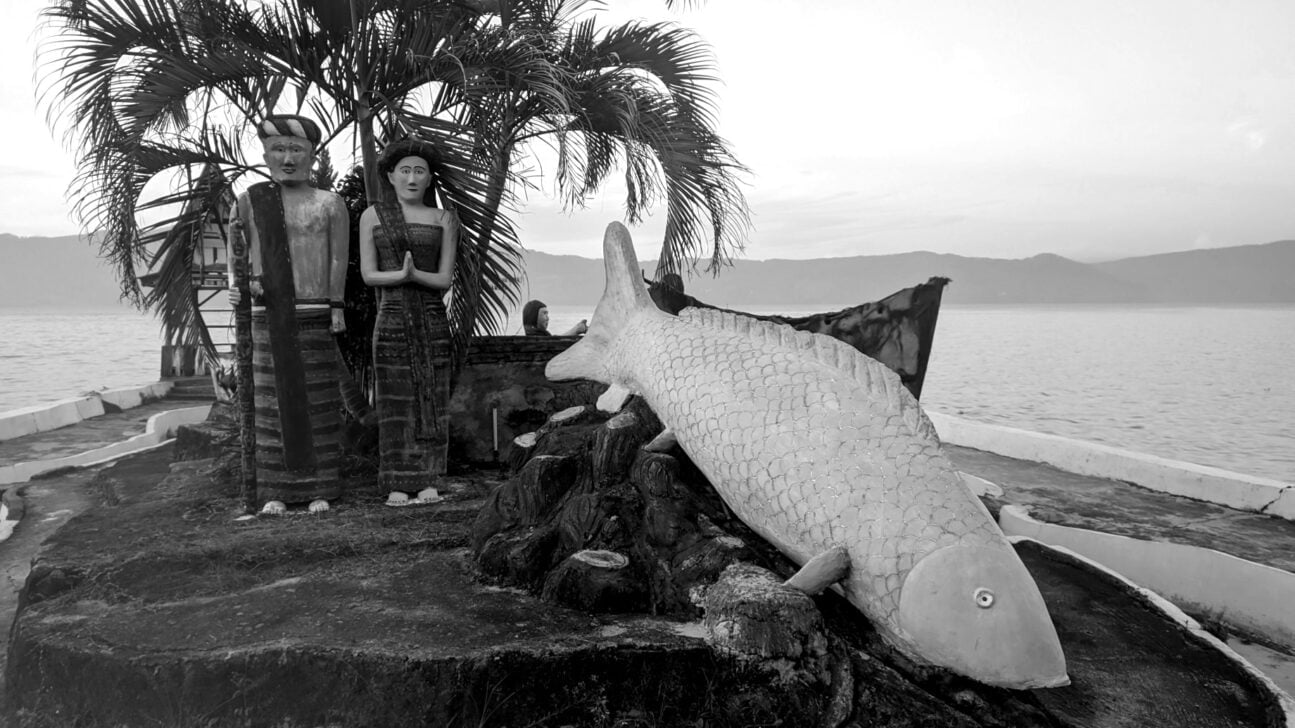
The Batak people

Batak is the name employed to refer collectively to the Toba, Karo, Simelungun, Pakpak, Angkola and Mandailing who occupy the wide region around Lake Toba in northern Sumatra. Although these groups and languages – all of the Austronesian family – display local variations there are strong cultural similarities in architecture, ancestral beliefs and customs.
The majority of the people are Christians while the Angkola and Mandailing adopted Islam from the early nineteenth century. Throughout history, Indian influence has trickled into local cultures and is visible in the Sanskrit-based Batak script – now rarely used – and some concepts of the ancestral beliefs. Many of these beliefs are reflected in the symbolism and meaning of Batak textiles.
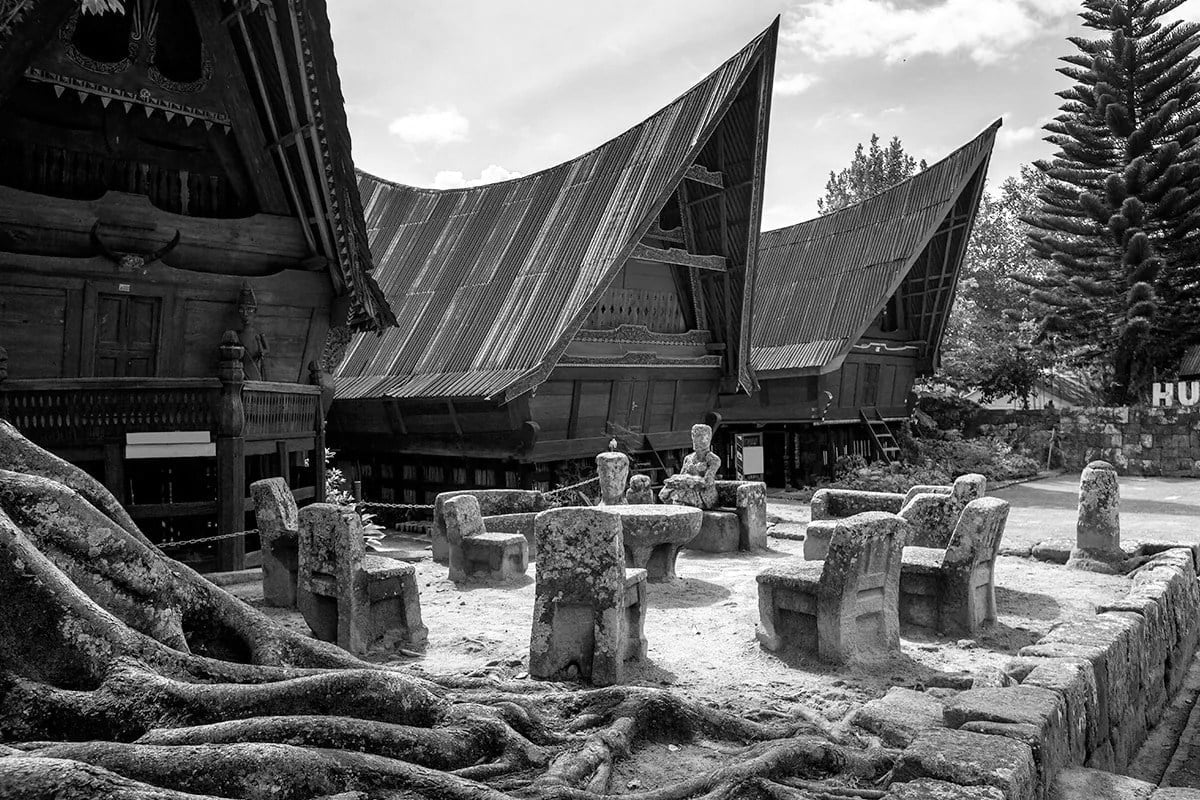
Traditional houses have thatch saddle-shaped roofs—that make the houses like as if they have horns—and timbers carved into graceful designs. The living quarters often is a large open space with no walls. Sometimes as many as a dozen families live in this area. Many have a distinctive trapdoor in the floor, large gable ends and buffalo horns.
Most traditional houses are built on stilts, up to two meters off the ground, and constructed of wood without nails using slots and twine. The roofs are made with sugar-palm leaves or corrugated metal. The gables often have carvings of horned lion heads, snakes, lizards or monsters with bulging eyes to protect the occupants from evil spirits. Animals are raised in the open space beneath the house. Rattan mats are often hung inside, giving the house a dark atmosphere. These days Malay-style concrete houses with metal roofs are common.
Batak mythology includes tales of gods, ancestors, ghosts and other mystical creatures closely connected to the life of the lake and the people.
MYTH: Where the Batak people came from
Sideak Parujar was a goddess who escaped from her lizard-like intended husband. She descended on a spun thread from the sky – the world of gods – to a middle world which then was still made only of shapeless waters. It was not comfortable there, but she resolved not to return back to the sky. Her caring grandfather sent her a handful of earth which she spread in such a way that it became broad and long. Unknowingly, she spread the earth on the head of a monstrous dragon, Naga Padoha, who lived in the waters of the underworld. The monster was not pleased and attempted to get rid of the earth by rolling around, making her life quite miserable. Resourceful Sideak Parujar plunged a sword into his body, up to the hilt and immobilized the monster. Every time Naga Padoha twists in his restraint an earthquake rumbles throughout the land.
And there is a twist to the story. Sideak Parujar’s former lizard-like suitor, in disguise, followed her to the Earth. The goddess married him and they were blessed with two children, twins, a boy and a girl. When the children had grown up the divine parents returned back to the god’s world in the sky.
The children formed an incestuous but happy union which resulted in humankind populating the Earth. The couple decided to settle on Pusut Buhit (1981 meters) – a volcano on the western shore of Lake Toba – where they founded the village of Si Anjur Mulamula. One of their grandchildren, Si Raja Batak is the mythological ancestor of the Batak people.
~ Dr Stan Florek after Achim Sibeth. The Batak.
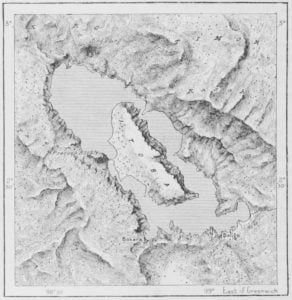
The Batak, arrived in the highlands about 3 to 4 thousand years ago from the Philippines and Borneo.
Europeans got knowledge about the sacred lake reasonably late. Marsden, which spend eight years in Bengkulu wrote in his “History of Sumatra” from 1811:
“It is said that there is a huge lake in North Sumatra, where exactly is not known.”
The Batak people in historical accounts
The first known Westerner to attempt to visit the interior Batak territories was Marco Polo, who in 1292 was denied entry into Batak lands. A purveyor of the gossip of the times, Marco Polo described the Bataks’ practice of occasional ritual cannibalism and wrote that:
Bataks ate the “rump to stump” of other people, including their own grandparents.
Marco Polo
This profoundly controversial statement set the stage, subsequently extending through the European colonial era, for the elaborate framing of Bataks as ‘man-eaters.’

Halting the purported ‘cannibalistic’ tendencies of the Bataks as well as ritual practices involving human sacrifice was employed as a pretext for the extension of European dominion and its frame of ‘rust en orde’ (peace and order) into the Batak realm during the 19th century.
Two British missionaries, Burton and Ward, spend a week in the Silidung valley in 1824, but were probably kept out of the way of the lake on purpose, which is considered sacred by the population.
The Toba Batak were highly resistant to any foreign intrusion on their lands, seeking to remain in a kind of protective isolation. Anyway Lake Toba was officially put on the map around 1850.
The first European to see Danau Toba was the Dutch linguist H.N. van der Tuuk, in 1853. The American missionaries Henry Lyman and Samuel Munson were less fortunate. Travelling from Sibolga to the Silindung Valley in 1834, they were attacked and killed by Toba Batak because they killed a Batak woman during hunting- they were simply eaten.
The legend of their death includes details suggesting they were cannibalized by those who killed them. However, the eating of their flesh was not intended for nourishment but was merely a symbolic, ritualized gesture intended to communicate emphatically to the outside that the Toba Batak would not tolerate intrusion by those from the outside. Shocking reports from the early literature tell that they are fierce headhunters, cannibals and warriors.
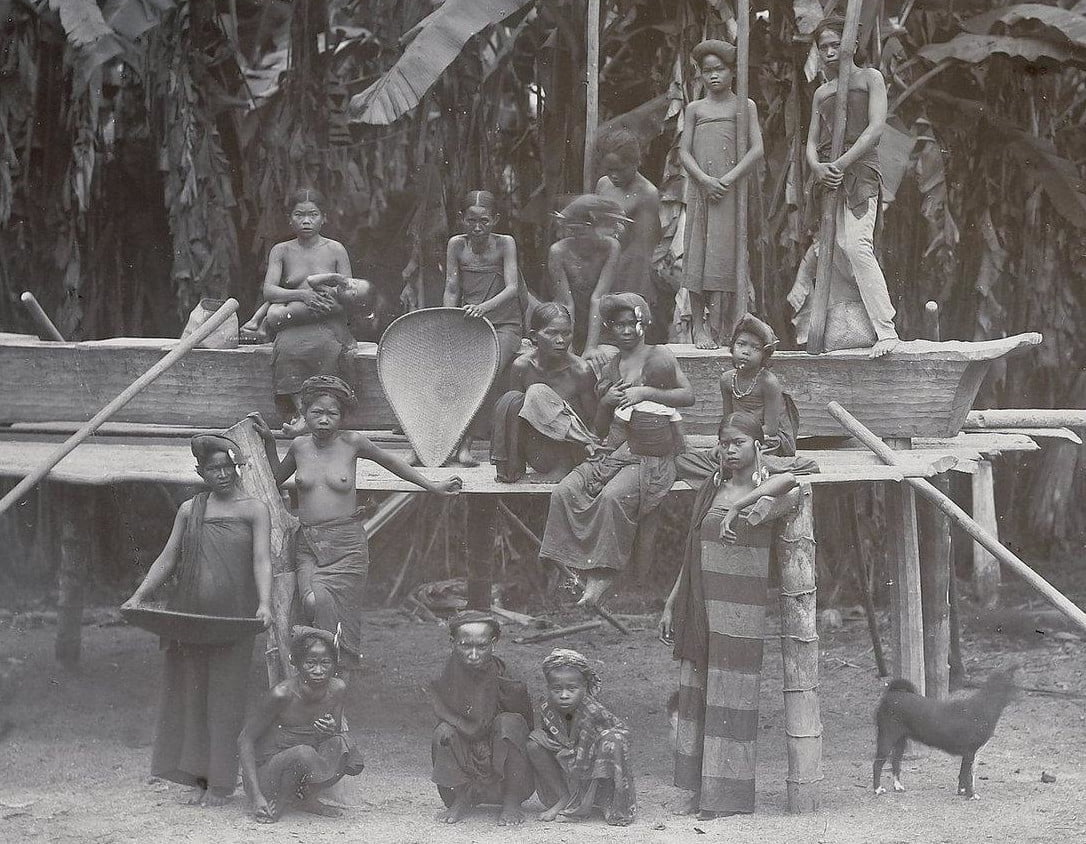
This image is kind of misleading. The Toba Batak didn’t only have their own writing and a highly developed culture, but also seemed to have early and long lasting trade contacts with each other and the outside world, but the impact of Islam upon the Batak was minimal.
From the memories of Sitor Situmorang we get an impression of the Batak country in the thirties. In 1931 he went to Balige, on the southern tip of Lake Toba:
…As the landscape to the north of the lake was dominated by groups of high steep mountains, Balige was also surrounded by mountain ranges which rose higher to the east, towards Habinsaran, where the sun rises, the source region of the Asahan stream.
… Behind that was a mysterious outerworld, just as this outer world, for centuries had considered the Batak countries a mysterious world, populated by tribes with scary habits, with a fascinating culture interwoven with legends and myths…”
The Batak were animists and embraced a number of gods and spirits. They also practiced sacrificial rituals, séances, divination, and sorcery. Occult spells, divination tables, and healing formulas were recorded on bark strips up to 50 feet [15 m] long and folded accordion-style, resulting in a book. And ornate sacred cloths were woven to ward off evil and to divine the future.
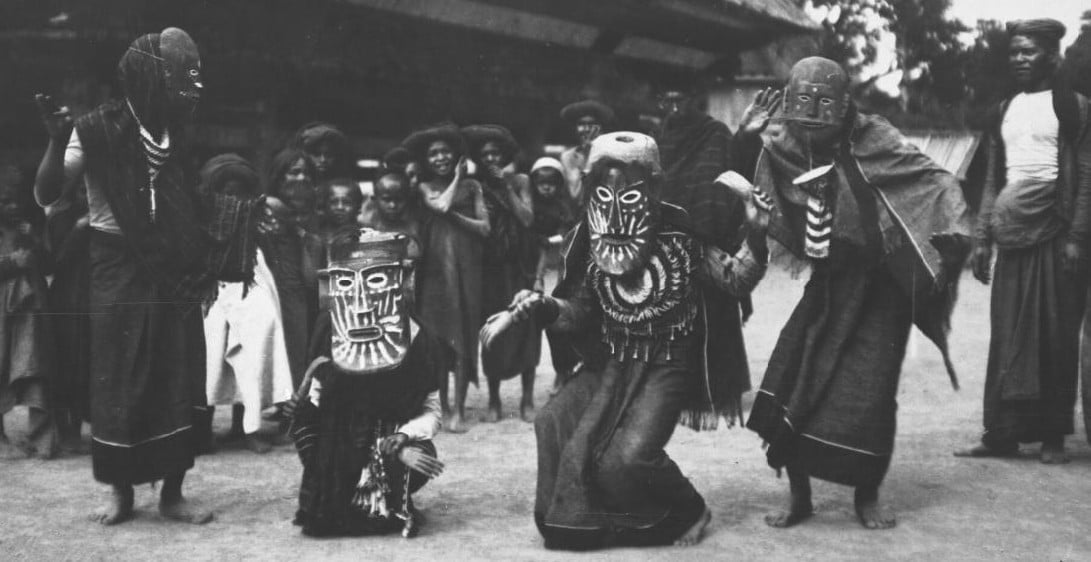
Bataks, while long renowned as fierce warriors, are extremely gracious and kind people with a deep history and a rich culture.
Batak Culture
The Batak have a rich oral and written traditional as expressed in verse-form verbal duets, mythic chants, dirges and clan genealogies. Bataks music was traditionally performed at religious ceremonies. The Batak are known throughout Indonesia as good singers. They are particularly famous for their emotional hymn singing. Batak traditional instruments are similar to those elsewhere in Indonesia: copper gongs struck with hammers, reedy wind instruments and a two string violin.
The Batak have a reputation for being skilled metal craftsmen. They used to have elaborate rituals, carvings and dances. Masked dances once served as a way of communicating with spirits and ancestors but now they are mostly performed for tourists. “Sahan” (Batak medicine holders made from buffalo horn) used to have a high degree of spiritual meaning. Now are they made mainly to sell to tourists, still made with high degree of artistic skill.
The human-sized puppets are now used more in marriage celebrations than for funerals. The puppets are carved from the wood of a Banyan tree and is dressed in a traditional costume, red turbans and blue sarongs. They are placed on wooden boxes and made to dance by puppeteers to gamelan music or flutes and drums. The origin of the art form is not known. According to one story it originated with a lonely widow who made a wooden image of her husband after he died and hired a puppeteer to make him dance and a mystic to communicate with the dead.
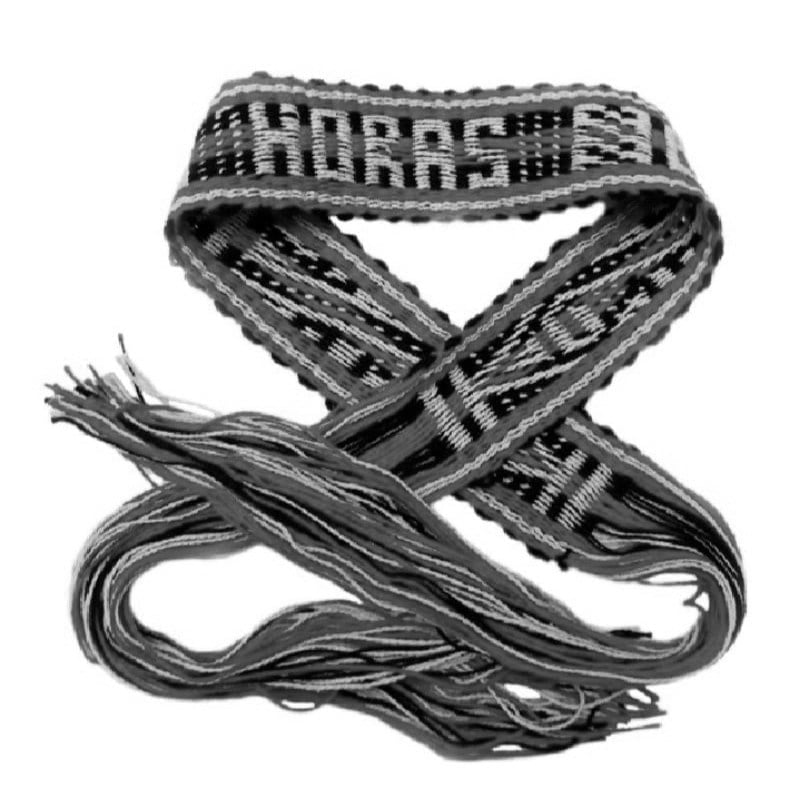
Horas is the Batak word to express gratefulness, happiness, and healthiness and commonly used as a simple greeting and goodbye. It is the equivalent to “hello”, “goodbye” or “Ciao
~ ○ ~
Keep exploring:
Works Cited & Multimedia Sources
- Couperus Louis. Eastward. 1923.
- Marsden William. History of Sumatra. 1811.
- Reclus, Elisée, Ravenstein, Ernest George, Keane, Augustus Henry. The earth and its inhabitants. 1882. Figure 37, Lake Toba and the Batta country.
- Situmorang Sitor. Poet of Lake Toba. Translator: A. L. Reber in Indonesia,Volume 56. 1993.
- Situmorang Sitor. De oude tijger (The Old Tiger, short stories). 1996.
- Excerpt from Indonesian Folktales Wiki.
- Batak krijgers met speren. Tropenmuseum, part of the National Museum of World Cultures.
- ERS SAR Mosaic of Sumatra, Peninsular Malaysia and Singapore.
- https://sukashareee.blogspot.com/2015/12/katastrofi-geologi-oleh-super-erupsi.html
- http://www.heartoftoba.com/
- Achim Sibeth. The Batak. London: Thames and Hudson, 1991.
- https://www.artoftheancestors.com/batak



